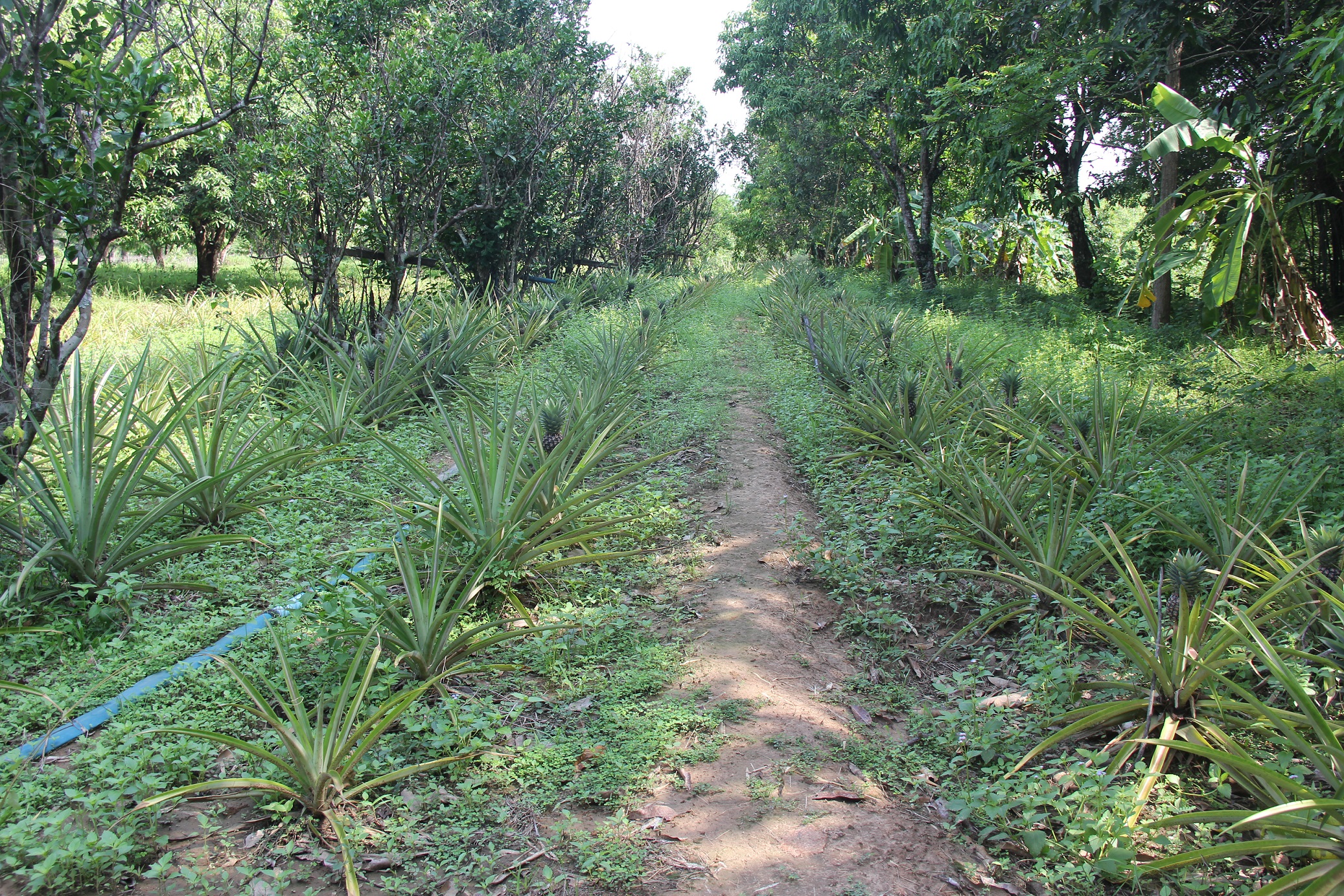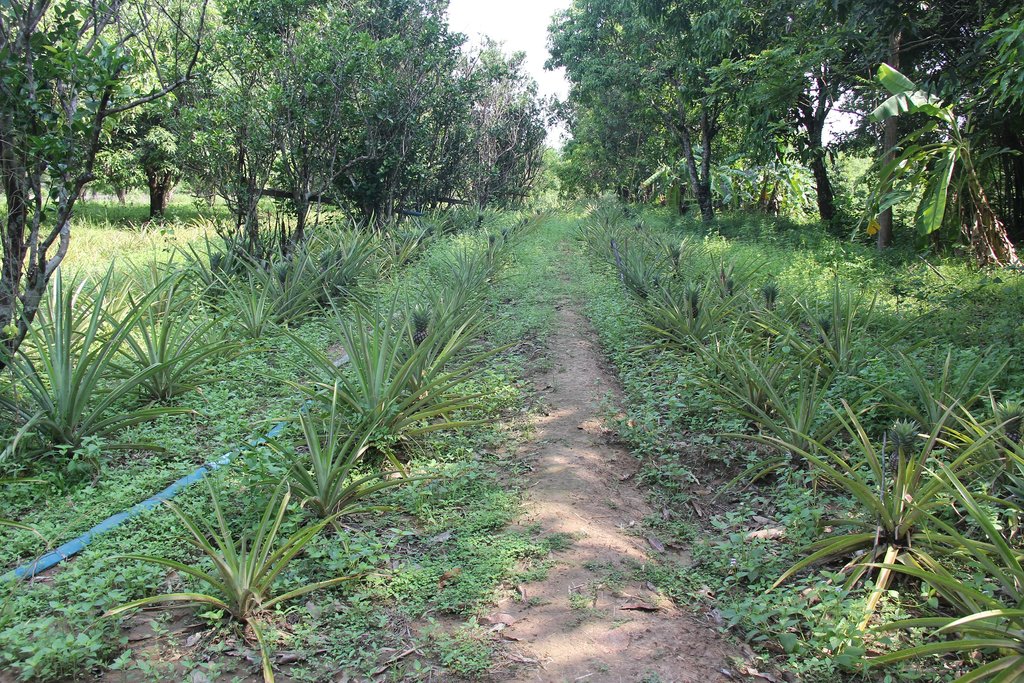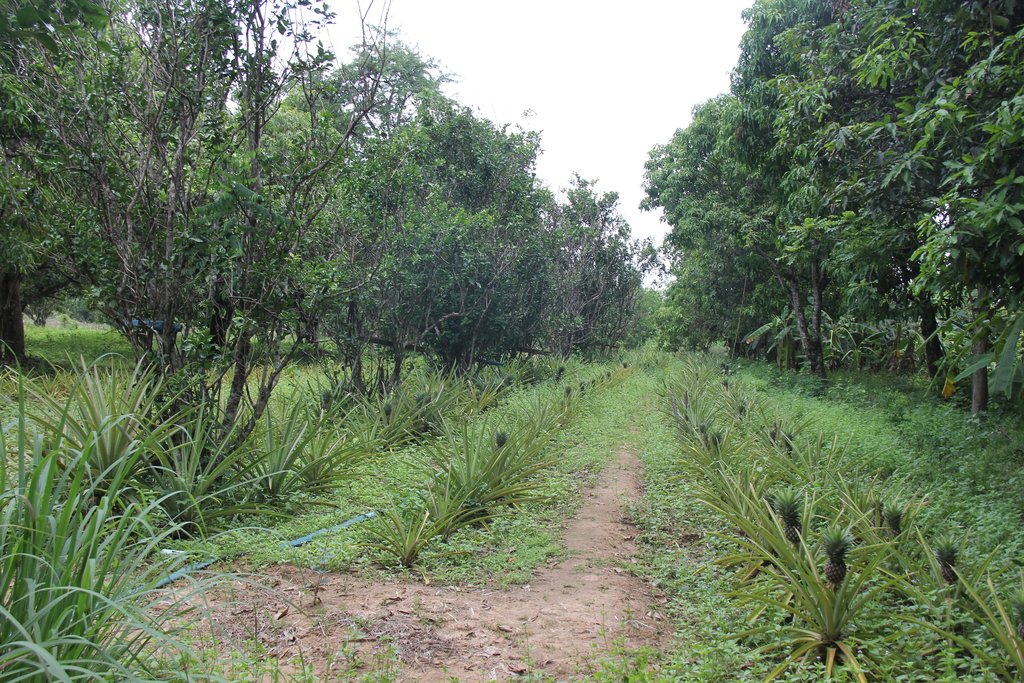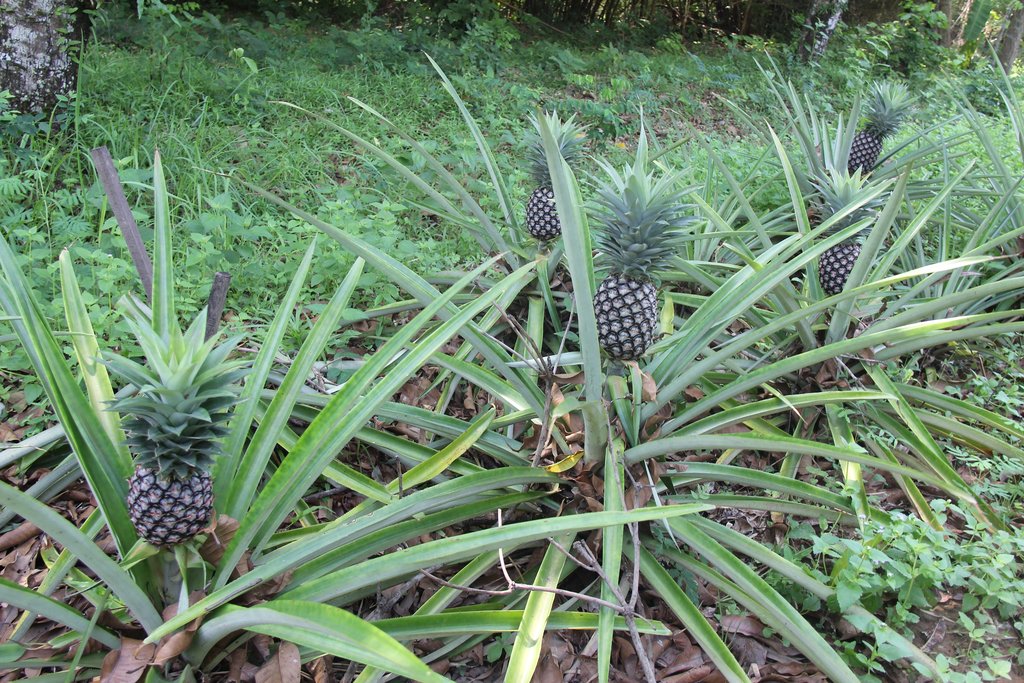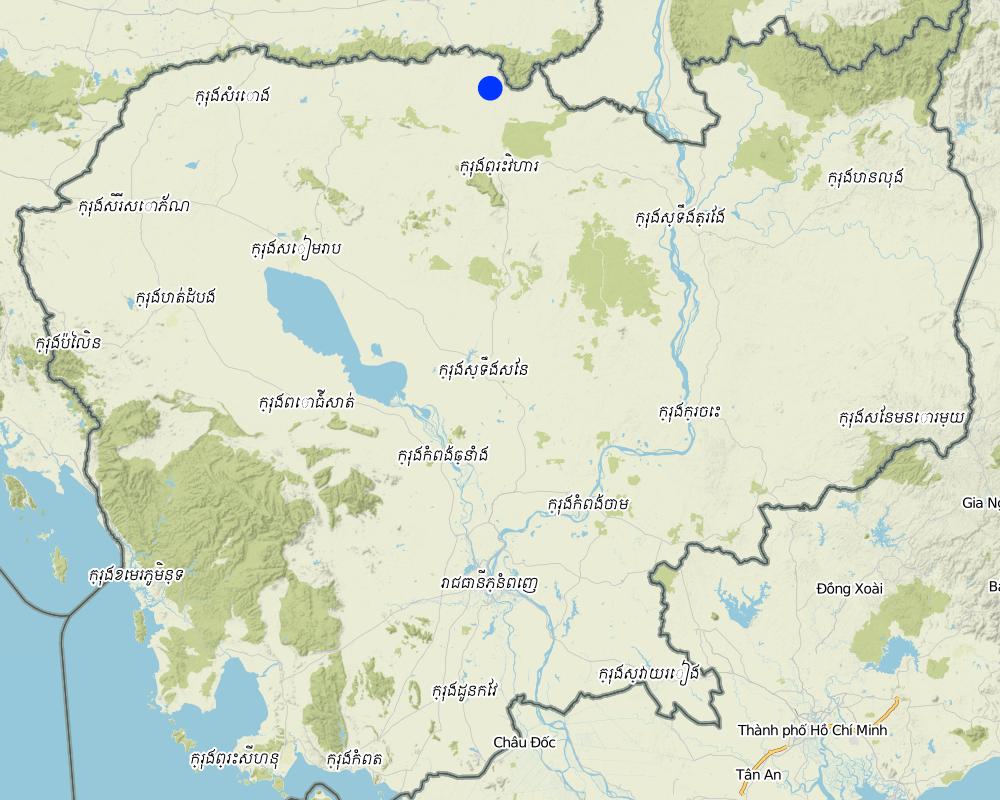កសិរុក្ខកម្ម - ការដាំម្នាស់នៅចន្លោះដំណាំស្វាយ និងក្រូចពោធិ៍សាត់ [Cambodia]
- Creation:
- Update:
- Compiler: Be Gechkim
- Editors: Sophea Tim, Navin Chea
- Reviewers: Ursula Gaemperli, Stephanie Jaquet, Nicole Harari, SO Than
technologies_2843 - Cambodia
View sections
Expand all Collapse all1. General information
1.2 Contact details of resource persons and institutions involved in the assessment and documentation of the Technology
Key resource person(s)
land user:
ដេត សូ
(+855) 97 49 88 398
មិនមានអ៊ីម៉ែល
កសិករ
ភូមិគោគស្រឡៅ ឃុំជាំក្សាន្ត ស្រុកជាំក្សាន្ត ខេត្តព្រះវិហារ
Cambodia
មន្ត្រីការិយាល័យកសិកម្ម រុក្ខាប្រមាញ់ និងនេសាទ ស្រុកជាំក្សាន្ត:
ឆ្លាត ប្រាជ្ញ
(+855) 97 48 25 806
មិនមានអ៊ីម៉ែល
ការិយាល័យកសិកម្មរុក្ខាប្រមាញ់ និងនេសាទ ស្រុកជាំក្សាន្ត
ភូមិជាំក្សាន្ត ឃុំជាំក្សាន្ត ស្រុកជាំក្សាន្ត ខេត្តព្រះវិហារ
Cambodia
ប្រធានការិយាល័យកសិកម្ម រុក្ខាប្រមាញ់ និងនេសាទ ស្រុកគូលែន:
ប្រធានការិយាល័យកសិកម្មរុក្ខាប្រមាញ់ និងនេសាទ ស្រុករវៀង:
មន្ត្រីមន្ទីរកសិកម្ម រុក្ខាប្រមាញ់ និងនេសាទ ខេត្តព្រះវិហារ:
Name of project which facilitated the documentation/ evaluation of the Technology (if relevant)
Scaling-up SLM practices by smallholder farmers (IFAD)Name of the institution(s) which facilitated the documentation/ evaluation of the Technology (if relevant)
Royal University of Agriculture (RUA) - Cambodia1.3 Conditions regarding the use of data documented through WOCAT
When were the data compiled (in the field)?
06/05/2017
The compiler and key resource person(s) accept the conditions regarding the use of data documented through WOCAT:
Ja
1.4 Declaration on sustainability of the described Technology
Is the Technology described here problematic with regard to land degradation, so that it cannot be declared a sustainable land management technology?
Nee
Comments:
បច្ចេកទេសនេះអាចចាត់ចូលជាប្រព័ន្ធកសិរុក្ខកម្ម ដែលប្រើប្រាស់តែជីធម្មជាតិ។
2. Description of the SLM Technology
2.1 Short description of the Technology
Definition of the Technology:
បច្ចេកទេសកសិរុក្ខកម្មដែលមានដាំដំណាំម្នាស់ជាមួយស្វាយ និងក្រូចពោធិ៍សាត់ដើម្បីរក្សាគុណភាពដី បង្កើនសេដ្ឋកិច្ច និងផ្តល់ផលិតផលច្រើនមុខដើម្បីបំរើតម្រូវការទីផ្សារ។
2.2 Detailed description of the Technology
Description:
កំណើននៃការបាត់បង់គម្របព្រៃឈើកាន់តែកើនឡើង ជាពិសេសនៅតំបន់ខ្ពង់រាប ដែលបណ្តាលមកពីកំណើនប្រជាជន កំណើនផ្ទៃដីកសិកម្ម ជាមូលហេតុនៃការធ្វើឱ្យដីមានការហូរច្រោះ ជីជាតិដីកាន់តែថយចុះ ដែលជាសញ្ញាណនៃឱនភាពដី (MPWT et al., 2016)។ កសិរុក្ខកម្មជាជម្រើសដ៏ល្អដែលអាចជួយដោះស្រាយបញ្ហានេះ ដោយផ្អែកលើអត្ថប្រយោជន៍របស់វាដូចជា កាត់បន្ថយការហូរច្រោះ បង្កើនសេដ្ឋកិច្ច ទិន្នផលដំណាំ ជីជាតិដី ថែមទាំងជួយរក្សាសំណើមដីផងដែរ។ កសិរុក្ខកម្មជាការដាំប្រភេទដំណាំប្រចាំឆ្នាំជាមួយដំណាំអាយុកាលវែងដូចជាដំណាំស្វាយ ក្រូច ជាមួយប្រភេទដំណាំបន្លែ ឬដំណាំផ្សេងៗនៅផ្នែកខាងក្រោម (MoE et al., 2016)។
កសិករអនុវត្តបច្ចេកទេសកសិរុក្ខកម្មនេះក្នុងគោលបំណងកាត់បន្ថយការប្រើប្រាស់ជីគីមី សន្សំសំចៃទឹក បង្កើនសំណើមដី បង្កើនចំណូល និងផលិតកម្មដំណាំ។ ក្នុងបច្ចេកទេសនេះកសិករបានដាំស្វាយ និងក្រូចពោធិ៍សាត់ ហើយដាំម្នាស់នៅតាមចន្លោះ ដោយសារម្នាស់ជាដំណាំ មិនត្រូវការពន្លឺថ្ងៃខ្លាំងអាចដាំក្រោមម្លប់បាន ហើយក៏ជាដំណាំធន់នឹងទឹកជំនន់ (រហូតដល់ ៧ថ្ងៃ) ដែរ។ តំបន់នេះម្តងម្កាល់តែងជន់លិចនៅពេលមានភ្លៀងខ្លាំង ដោយសារតែស្ថិតនៅជិតស្ទឹងដែលអាចជន់លិចត្រឹមតែរយៈពេល ២៤ម៉ោង ប៉ុណ្ណោះរួចទឹកនឹងស្រកទៅវិញ ។ ម្យ៉ាងវិញទៀត កសិករមិនបានប្រើប្រាស់ជី ឬថ្នាំគីមីឡើយ គឺប្រើតែកាកសំណល់ដំណាំ ស្លឹកឈើ រុក្ខជាតិតូចៗ ស្មៅដែលកាត់ចោលជាដើម។ ជាធម្មតាដំណាំស្វាយ និងក្រូចពោធិ៍សាត់ជាដំណាំអាយុកាលវែង ពេលដើមនៅតូច គឺចន្លោះគុម្ពមានគម្លាតឆ្ងាយ។ បើទុកដីមិនប្រើប្រាស់ (ចំហរ) នឹងមានស្មៅចង្រៃដុះទ្រុបទ្រុល ពិបាកក្នុងការសម្អាត និងថែទាំដំណាំ។ ដូចនេះការដាំម្នាស់តាមចន្លោះនឹងទទួលបានចំណូលជាបណ្តើរៗមុនពេលស្វាយ និងក្រូចផ្តល់ផល ចំណេញពេលវេលាថែទាំ ស្រោចទឹក ដាក់ជី ដកស្មៅ។ លើសពីនេះទៅទៀតនៅពេលស្វាយ និងក្រូចធំ ម្នាស់ក៏នៅតែអាចបន្តផ្តល់ផល បើទោះជាដុះក្រោមម្លប់ហើយមានពន្លឺតិចតួចក្តី តែទិន្នផលមិនបានច្រើនទេ។ ម៉្យាងទៀតការដាំម្នាស់ គឺជាការបង្កើនមុខដំណាំសម្រាប់ទីផ្សារ ដោយនៅតំបន់នេះមិនទាន់មានអ្នកដាំម្នាស់នៅឡើយទេ។
នៅក្នុងទំហំផ្ទៃ ២០០០ ម៉ែត្រការ៉េ (ទទឹង ២០ម៉ែត្រ X ១០០ ម៉ែត្រ) ដែលមានដាំក្រូចពោធិ៍សាត់ចំនួន ១០ដើម ស្វាយចំនួន ១៤ដើម និងម្នាស់ប្រមាណជា ១០០០ដើម។ ក្នុងនោះស្វាយដាំជា ២ជួរនៅព្រំដីសងខាងដែលមួយជួរមានដើមស្វាយ ៦ ទៅ ៧ដើម ហើយដាំក្រូចពោធិ៍សាត់នៅចន្លោះកណ្តាល និងមានម្នាស់នៅចន្លោះស្វាយ និងក្រូចពោធិ៍សាត់ផងដែរ។ ការដាំស្វាយត្រូវជីករណ្តៅកន្លះម៉ែត្របួនជ្រុង និងជម្រៅ ០,៥ម៉ែត្រ ហើយប្រមូលស្លឹកឈើជាមួយកាកសំណល់ផ្សេងៗទុកមួយឆ្នាំមុននឹងដាក់ដាំ និងដាំនៅចន្លោះ ១៥ម៉ែត្រ បួនជ្រុង។ ក្រូចពោធិ៍សាត់ដាំក្នុងចន្លោះ ៤ម៉ែត្របួនជ្រុង ដោយមានលើកភ្លឺកម្ពស់ ២០សង់ទីម៉ែត្រ ប្រវែង ២ម៉ែត្រជុំវិញ ហើយជីករណ្តៅដូចការដាំស្វាយដែរ ។ ការដាំប្រព្រឹត្តទៅនៅអំឡុងខែឧសភា ឬមិថុនា និងបន្ទាប់ពីមានភ្លៀងធ្លាក់ម្តង ឬពីរដងបានចាប់ផ្តើមដាំ ហើយក្រោយពេលដាំ ៣ ទៅ ៤ខែធ្វើស្មៅម្តង និងបន្ថែមលាមកគោក្រោយដាំបានមួយឆ្នាំ។ ដោយឡែកម្នាស់ត្រូវបានដាំក្នុងចន្លោះមួយម៉ែត្រពីគ្នាហើយដាំជារាងមុំចង្ក្រាន ដោយជីករណ្តៅ ២០សង់ទីម៉ែត្របួនជ្រុង ជម្រៅ ១០សង់ទីម៉ែត្រ បើជ្រៅពេកវាអាចរលួយ។ ក្នុងមួយឆ្នាំគាត់ដាំតែម្តងទេ ព្រោះថាម្នាស់បន្ទាប់ពីដាំរហូតដល់ប្រមូលផលមានរយៈពេល ៩ ទៅ ១០ ខែ ហើយបន្ទាប់ពីប្រមូលផលរួចត្រូវចំណាយពេល ១ ទៅ ២ខែបន្ថែមដើម្បីឱ្យវាចេញខ្នែង និងត្រូវរងចាំដល់ខ្នែងនោះលាស់ស្លឹកប្រមាណជា ១០សន្លឹកទៀតទើបកាត់ខ្នែងនោះសម្រាប់ដាំបន្ត។ កាកសំណល់ដើមម្នាស់ដែលសេសសល់ត្រូវប្រមូលសម្អាតហើយកប់ក្នុងដីនៅផ្នែកណាមួយនៃផ្ទៃដីដាំដុះសម្រាប់ផ្តល់ជាជីជាតិវិញ។
2.3 Photos of the Technology
2.4 Videos of the Technology
Comments, short description:
មិនមាន
Name of videographer:
មិនមាន
2.5 Country/ region/ locations where the Technology has been applied and which are covered by this assessment
Country:
Cambodia
Region/ State/ Province:
ភូមិគោកស្រឡៅ ឃុំជាំក្សាន្ត ស្រុកជាំក្សាន្ត ខេត្តព្រះវិហារ
Map
×2.6 Date of implementation
Indicate year of implementation:
2007
If precise year is not known, indicate approximate date:
- 10-50 years ago
2.7 Introduction of the Technology
Specify how the Technology was introduced:
- through land users' innovation
Comments (type of project, etc.):
ឆ្លងកាត់តាមការពិសោធន៍ច្រើនឆ្នាំដោយសាកល្បងជាមួយដំណាំផ្សេងរហូតដល់ការដាំដំណាំម្នាស់ដែលត្រូវនឹងអ្វីដែលគាត់ចង់បានជាងគេ (ឧ. មានទាំងតម្រូវការទីផ្សារ ត្រូវពន្លឺថ្ងៃតិចក៏បាន និងមិនតម្រូវការថ្នាំគីមីច្រើនទេ ។ល។)។
3. Classification of the SLM Technology
3.1 Main purpose(s) of the Technology
- improve production
- conserve ecosystem
- create beneficial economic impact
3.2 Current land use type(s) where the Technology is applied

Mixed (crops/ grazing/ trees), incl. agroforestry
- Agroforestry
Main products/ services:
មានដំណាំស្វាយ ក្រូចពោធិ៍សាត់ និងម្នាស់
If land use has changed due to the implementation of the Technology, indicate land use before implementation of the Technology:
ដំបូងឡើយជាប្រភេទដីព្រៃ តែក្រោយមកក្លាយជាដីស្រែ និងចុងក្រោយនេះបានក្លាយជាដីដាំដំណាំ។
3.3 Further information about land use
Water supply for the land on which the Technology is applied:
- mixed rainfed-irrigated
Comments:
អាចទទួលបានទឹកពីស្ទឹងដែលនៅក្បែរផ្ទះ ប៉ុន្តែនៅតែអាចទាញយកទឹកបានខ្លះ បើទោះជាស្ទឹងរីងនៅចុងខែមីនា។
Number of growing seasons per year:
- 1
Specify:
ម្នាស់ជាដំណាំមួយប្រភេទត្រូវការពេលមួយឆ្នាំចាប់ពីពេលដាំរហូតដល់ប្រមូលផល ដោយបន្ទាប់ពីចេញផ្លែបាន ៣ខែទើបអាចប្រមូលផលបាន។
3.4 SLM group to which the Technology belongs
- agroforestry
- improved ground/ vegetation cover
3.5 Spread of the Technology
Specify the spread of the Technology:
- evenly spread over an area
If the Technology is evenly spread over an area, indicate approximate area covered:
- < 0.1 km2 (10 ha)
3.6 SLM measures comprising the Technology

agronomic measures
- A1: Vegetation/ soil cover
- A2: Organic matter/ soil fertility
3.7 Main types of land degradation addressed by the Technology

soil erosion by water
- Wt: loss of topsoil/ surface erosion

chemical soil deterioration
- Cn: fertility decline and reduced organic matter content (not caused by erosion)

water degradation
- Ha: aridification
3.8 Prevention, reduction, or restoration of land degradation
Specify the goal of the Technology with regard to land degradation:
- prevent land degradation
- reduce land degradation
4. Technical specifications, implementation activities, inputs, and costs
4.1 Technical drawing of the Technology
4.2 Technical specifications/ explanations of technical drawing
បច្ចេសទេសនេះត្រូវបានអនុវត្តលើផ្ទៃដីទំហំ ២០០០ ម៉ែត្រការ៉េ ដែលមានដាំក្រូចពោធិ៍សាត់ ១០ដើម ស្វាយ ១៤ដើម និងម្នាស់ប្រមាណជា ១០០០ដើម។ ដាំស្វាយត្រូវបានដាំជា ២ជួរនៅសងខាងដី (ដែលក្នុងមួយជួរមាន ៦ ទៅ ៧ ដើម)។ ក្រូចពោធិ៍សាត់ត្រូវបានដាំនៅកណ្តាលដី ហើយម្នាស់ត្រូវបានដាំនៅចន្លោះក្រូច និងស្វាយ។ ការដាំស្វាយត្រូវជីករណ្តៅកន្លះម៉ែត្របួនជ្រុង និងជម្រៅ ០,៥ម៉ែត្រ ហើយប្រមូលស្លឹកឈើជាមួយកាកសំណល់ផ្សេងៗទុកមួយឆ្នាំមុននឹងដាក់ដាំ និងដាំនៅចន្លោះ ១៥ម៉ែត្រ បួនជ្រុង។ ក្រូចពោធិ៍សាត់ដាំក្នុងចន្លោះ ៤ម៉ែត្របួនជ្រុង ដោយមានលើកភ្លឺកម្ពស់ ២០សង់ទីម៉ែត្រ ប្រវែង ២ម៉ែត្រជុំវិញ ហើយជីករណ្តៅដូចការដាំស្វាយដែរ។ ដោយឡែកម្នាស់ត្រូវបានដាំក្នុងចន្លោះមួយម៉ែត្រពីគ្នាហើយដាំជារាងមុំចង្ក្រាន ដោយជីករណ្តៅ ២០សង់ទីម៉ែត្របួនជ្រុង ជម្រៅ ១០សង់ទីម៉ែត្រ បើជ្រៅពេកវាអាចរលួយ។
4.3 General information regarding the calculation of inputs and costs
Specify how costs and inputs were calculated:
- per Technology area
Indicate size and area unit:
២០ X ១០០ = ២០០០ ម៉ែត្រការ៉េ
other/ national currency (specify):
រៀល
Indicate exchange rate from USD to local currency (if relevant): 1 USD =:
4000.0
Indicate average wage cost of hired labour per day:
២០០០០ រៀល
4.4 Establishment activities
| Activity | Type of measure | Timing | |
|---|---|---|---|
| 1. | ភ្ជួរដី៣ ដង និងហាលពី២-៣ថ្ងៃ | Agronomic | ខែ មេសា ទៅឧសភា ហើយបន្ទាប់ពីមានភ្លៀងធ្លាក់ |
| 2. | រាស់បំបែកដីហាល ២-៣ថ្ងៃ | Agronomic | ខែ មេសា ទៅឧសភា |
| 3. | ជីករណ្តៅដាំ | Agronomic | ខែ មេសា ទៅឧសភា |
| 4. | ដាំស្វាយ | Agronomic | ខែ មេសា ទៅឧសភា |
| 5. | ដាំក្រូច | Agronomic | ខែ មេសា ទៅឧសភា |
| 6. | ដាំម្នាស់ | Agronomic | ខែ មេសា ទៅឧសភា |
4.5 Costs and inputs needed for establishment
| Specify input | Unit | Quantity | Costs per Unit | Total costs per input | % of costs borne by land users | |
|---|---|---|---|---|---|---|
| Labour | ភ្ជួរដី | នាក់/ថ្ងៃ | 7.5 | 20000.0 | 150000.0 | 100.0 |
| Labour | ជីករណ្តៅ | នាក់/ថ្ងៃ | 3.0 | 20000.0 | 60000.0 | 100.0 |
| Equipment | ប៉ែល | ប៉ែល | 1.0 | 8000.0 | 8000.0 | 100.0 |
| Equipment | ចបកាប់ | ចប | 1.0 | 15000.0 | 15000.0 | 100.0 |
| Equipment | ចបជីក | ចប | 2.0 | 13000.0 | 26000.0 | 100.0 |
| Plant material | កូនស្វាយ | ដើម | 15.0 | 4000.0 | 60000.0 | 100.0 |
| Plant material | កូនក្រូច | ដើម | 10.0 | 15000.0 | 150000.0 | 100.0 |
| Total costs for establishment of the Technology | 469000.0 | |||||
4.6 Maintenance/ recurrent activities
| Activity | Type of measure | Timing/ frequency | |
|---|---|---|---|
| 1. | ស្រោចទឹកស្វាយ និងក្រូចពោធិ៍សាត់ | Agronomic | មួយសប្តាហ៍ម្តង |
| 2. | ស្រោចទឹកម្នាស់ | Agronomic | មួយសប្តាហ៍ម្តង |
| 3. | ធ្វើស្មៅ និងជ្រោយដី | Agronomic | ២០ ថ្ងៃម្តង |
| 4. | ការដាក់លាមកសត្វ | Agronomic | មួយដងក្នុងមួយឆ្នាំ |
4.7 Costs and inputs needed for maintenance/ recurrent activities (per year)
| Specify input | Unit | Quantity | Costs per Unit | Total costs per input | % of costs borne by land users | |
|---|---|---|---|---|---|---|
| Labour | ស្រោចទឹក | នាក់/ថ្ងៃ | 52.0 | 20000.0 | 1040000.0 | 100.0 |
| Labour | ធ្វើស្មៅ និងជ្រោយដី | នាក់/ថ្ងៃ | 20.0 | 20000.0 | 400000.0 | 100.0 |
| Labour | ការដាក់លាមកសត្វ | នាក់/ថ្ងៃ | 1.0 | 20000.0 | 20000.0 | 100.0 |
| Equipment | ម៉ាស៊ីនបូមទឹក | គ្រឿង | 1.0 | 2000000.0 | 2000000.0 | 100.0 |
| Equipment | ម៉ាស៊ីនកាត់ស្មៅ | គ្រឿង | 1.0 | 300000.0 | 300000.0 | 100.0 |
| Equipment | គោយន្ត | គ្រឿង | 1.0 | 4700000.0 | 4700000.0 | 100.0 |
| Fertilizers and biocides | លាមកសត្វ | គីឡូក្រាម | 100.0 | 200.0 | 20000.0 | 100.0 |
| Construction material | ប្រេងសម្រាប់បូមទឹក | លីត្រ | 30.0 | 3500.0 | 105000.0 | 100.0 |
| Construction material | ប្រេងសម្រាប់កាត់ស្មៅ | លីត្រ | 260.0 | 3500.0 | 910000.0 | 100.0 |
| Total costs for maintenance of the Technology | 9495000.0 | |||||
4.8 Most important factors affecting the costs
Describe the most determinate factors affecting the costs:
ការភ្ជួររាស់ និងប្រេងសម្រាប់បូមទឹក
5. Natural and human environment
5.1 Climate
Annual rainfall
- < 250 mm
- 251-500 mm
- 501-750 mm
- 751-1,000 mm
- 1,001-1,500 mm
- 1,501-2,000 mm
- 2,001-3,000 mm
- 3,001-4,000 mm
- > 4,000 mm
Specify average annual rainfall (if known), in mm:
1429.30
Specifications/ comments on rainfall:
បរិមាណទឹកភ្លៀងប្រចាំឆ្នាំ ២០១៥ មានចំនួន ១៤២៩.៣ មម និងឆ្នាំ ២០១៤ មានចំនួន ១៦៤៧.៣ មម។
Indicate the name of the reference meteorological station considered:
ក្រសួងធនធានទឹក និងឧតុនិយម (២០១៥)
Agro-climatic zone
- sub-humid
មាន ២រដូវកាល គឺរដូវប្រាំង និងរដូវវស្សា
5.2 Topography
Slopes on average:
- flat (0-2%)
- gentle (3-5%)
- moderate (6-10%)
- rolling (11-15%)
- hilly (16-30%)
- steep (31-60%)
- very steep (>60%)
Landforms:
- plateau/plains
- ridges
- mountain slopes
- hill slopes
- footslopes
- valley floors
Altitudinal zone:
- 0-100 m a.s.l.
- 101-500 m a.s.l.
- 501-1,000 m a.s.l.
- 1,001-1,500 m a.s.l.
- 1,501-2,000 m a.s.l.
- 2,001-2,500 m a.s.l.
- 2,501-3,000 m a.s.l.
- 3,001-4,000 m a.s.l.
- > 4,000 m a.s.l.
Indicate if the Technology is specifically applied in:
- not relevant
5.3 Soils
Soil depth on average:
- very shallow (0-20 cm)
- shallow (21-50 cm)
- moderately deep (51-80 cm)
- deep (81-120 cm)
- very deep (> 120 cm)
Soil texture (topsoil):
- fine/ heavy (clay)
Soil texture (> 20 cm below surface):
- fine/ heavy (clay)
Topsoil organic matter:
- high (>3%)
If available, attach full soil description or specify the available information, e.g. soil type, soil PH/ acidity, Cation Exchange Capacity, nitrogen, salinity etc.
កម្រិត pH=៦ ដីស្រទាប់ខាងលើ និងក្រោមសុទ្ធជាប្រភេទដីកណ្តេង។
5.4 Water availability and quality
Ground water table:
5-50 m
Availability of surface water:
good
Water quality (untreated):
for agricultural use only (irrigation)
Is water salinity a problem?
Nee
Is flooding of the area occurring?
Ja
Regularity:
frequently
Comments and further specifications on water quality and quantity:
ជន់ត្រឹម ១-២ថ្ងៃប៉ុណ្ណោះ ដោយសារជាតំបន់ខ្ពង់រាបឆាប់ហូរអស់ និងជាធម្មតាទឹកជន់ពី ៤-៥ដងក្នុងមួយឆ្នាំ។
5.6 Characteristics of land users applying the Technology
Sedentary or nomadic:
- Sedentary
Market orientation of production system:
- commercial/ market
Off-farm income:
- less than 10% of all income
Relative level of wealth:
- average
Individuals or groups:
- individual/ household
Level of mechanization:
- manual work
- mechanized/ motorized
Gender:
- men
Age of land users:
- elderly
5.7 Average area of land owned or leased by land users applying the Technology
- < 0.5 ha
- 0.5-1 ha
- 1-2 ha
- 2-5 ha
- 5-15 ha
- 15-50 ha
- 50-100 ha
- 100-500 ha
- 500-1,000 ha
- 1,000-10,000 ha
- > 10,000 ha
Is this considered small-, medium- or large-scale (referring to local context)?
- small-scale
Comments:
មានដីចំនួន ២ហិកតា ជាដីដាំដំណាំជុំវិញផ្ទះ និង ៥០ម៉ែត្រx៦០ម៉ែត្រ ជាដីដាំចេកជាដីក្មួយ
5.8 Land ownership, land use rights, and water use rights
Land ownership:
- individual, titled
Land use rights:
- individual
- ដីក្មួយ
Water use rights:
- open access (unorganized)
Comments:
ជាប្រភេទដីដែលមានប័ណ្ណកម្មសិទ្ធិជាលក្ខណៈបុគ្គលប៉ុន្តែវាមានលក្ខណៈមិនទូលំទូលាយ ឬត្រឹមត្រូវស្របច្បាប់នោះទេ។ ហេតុដូចនេះនៅក្នុងប្រទេសកម្ពុជាប័ណ្ណកម្មសិទ្ធប្រភេទនេះត្រូវបានគេឱ្យឈ្មោះថា "ប្លង់ទន់ ឬប័ណ្ណទន់" ។ អនុលោមតាមច្បាប់ភូមិបាលឆ្នាំ 2001 មានន័យថាវាជាប័ណ្ណកម្មសិទិ្ធដីធ្លីរបស់ប្រទេសកម្ពុជាដែលត្រូវបានទទួលស្គាល់នៅថ្នាក់រដ្ឋបាលមូលដ្ឋាន។ ប្លង់ទន់ ឬប័ណ្ណទន់ត្រូវបានផ្តល់ឱ្យដោយសង្កាត់ ឬការិយាល័យស្រុក ហើយមិនត្រូវបានចុះបញ្ជីនៅថ្នាក់ជាតិនោះទេ ប៉ុន្តែនៅតែត្រូវបានទទួលស្គាល់ថាជាកម្មសិទ្ធិដែរ។ ភាគច្រើននៃប្រតិបត្តិការអចលនទ្រព្យនៅតែកើតមានឡើងដោយប្រើប្រាស់ត្រឹមតែប័ណ្ណទន់ដើម្បីជៀសវាងការចំណាយថ្លៃលើសេវាផ្ទេរកម្មសិទ្ធ និងសេវាពន្ធលើអចលនទ្រព្យ។
5.9 Access to services and infrastructure
health:
- poor
- moderate
- good
education:
- poor
- moderate
- good
technical assistance:
- poor
- moderate
- good
employment (e.g. off-farm):
- poor
- moderate
- good
markets:
- poor
- moderate
- good
energy:
- poor
- moderate
- good
roads and transport:
- poor
- moderate
- good
drinking water and sanitation:
- poor
- moderate
- good
financial services:
- poor
- moderate
- good
6. Impacts and concluding statements
6.1 On-site impacts the Technology has shown
Socio-economic impacts
Production
crop production
Comments/ specify:
ពីមុនដាំច្រើនមុខជាងដែលបណ្តាលឱ្យថយផលិតកម្មដំណាំតិចតួច ប៉ុន្តែមានតម្រូវការទីផ្សារខ្ពស់ជាងមុន។
crop quality
Comments/ specify:
មានរុយចោះ ៧-៨ឆ្នាំចុងក្រោយ
risk of production failure
Comments/ specify:
មានដាំដំណាំរយៈពេលវែង និងដំណាំរយៈពេលខ្លី ដែលជួយកាត់បន្ថយហានិភ័យបានតិចតួច ហើយកសិករក៏មិនមានប្រើប្រាស់ជីថ្នាំគីមីដែរ។
product diversity
Comments/ specify:
មានដំណាំ ៣ប្រភេទនៅលើដី
land management
Comments/ specify:
វាមានដំណាំ ២ប្រភេទ គឺដំណាំរយៈពេលវែង និងដំណាំរយៈពេលខ្លី ហើយវាជួយកាត់បន្ថយស្មៅចង្រៃ និងទឹកសម្រាប់ស្រោចស្រពដែរ។
Income and costs
expenses on agricultural inputs
Comments/ specify:
ដាំម្នាស់ចំណាយច្រើនជាងដោយសារត្រូវចំណាយលើការប្រេងសម្រាប់ស្រោចស្រពព្រោះមានរយៈពេលយូរជាង។
farm income
Comments/ specify:
ផលិតកម្មថយចុះបន្តិច ប៉ុន្តែកសិករទទួលបានតម្លៃប្រសើរជាងមុនដោយសារតម្រូវការទីផ្សារស្វាយ ក្រូចពោធិ៍សាត់ និងម្នាស់កើនឡើង។
workload
Comments/ specify:
បន្ទុកការងារត្រូវបានកាត់បន្ថយដោយសារមិនសូវមានស្មៅដុះ និងការស្រោចស្រពតិចជាងមុន។
Socio-cultural impacts
health situation
Comments/ specify:
កសិករមិនបានប្រើថ្នាំគីមីក្នុងការអនុវត្តបច្ចេកទេសនេះទេ។
SLM/ land degradation knowledge
Comments/ specify:
គាត់បានផ្លាស់ប្តូរពីការប្រើប្រាស់ជីគីមីមកប្រើជីធម្មជាតិវិញ។
Ecological impacts
Soil
soil moisture
Comments/ specify:
សំណើមដីត្រូវបានកើនឡើងដោយសារដីត្រូវបានគ្របដណ្តប់ដោយដំណាំ។
soil cover
Comments/ specify:
ដំណាំរយៈពេលវែង និងប្រចាំឆ្នាំត្រូវបានដាំសម្រាប់ជាប្រចាំ។
soil crusting/ sealing
Comments/ specify:
ដីប្រេះបែកក្រហែងត្រូវបានកាត់បន្ថយតាមរយៈការដាំឈើហូបផ្លែដែលអាចបង្កើនសំណើមដី។
soil compaction
Comments/ specify:
ឈើហូបផ្លែ ឬដំណាំរយៈពេលវែងត្រូវបានដាំដូចនេះឫសរបស់វាអាចជួយកាត់បន្ថយការហាប់ណែននៃដីជាងការដាំបន្លែទូទៅ។
nutrient cycling/ recharge
Comments/ specify:
វដ្តនៃសារធាតុចិញ្ចឹមបានកើនឡើងដោយសារតែការប្រើប្រាស់កាកសំណល់ដំណាំ និងស្លឹកឈើ ឬស្លឹករុក្ខជាតិផ្សេងៗ។
soil organic matter/ below ground C
Comments/ specify:
សព្វថ្ងៃគាត់ប្រើជីធម្មជាតិជំនួសជីគីមីដែលធ្វើឱ្យសារធាតុសរីរាង្គក្នុងដីកើនឡើង។
Biodiversity: vegetation, animals
plant diversity
Comments/ specify:
ដំណាំរយៈពេលវែង និងដំណាំប្រចាំឆ្នាំត្រូវបានដាំជាប្រចាំ។
invasive alien species
beneficial species
Comments/ specify:
ប្រភេទសត្វដែលមានប្រយោជន៍ត្រូវបានកើនឡើងដោយសារតែការប្រើប្រាស់ជីធម្មជាតិ។
pest/ disease control
Climate and disaster risk reduction
drought impacts
Comments/ specify:
ឫសរបស់ឈើហូបផ្លែ និងម្នាស់បានចាក់ចូលក្នុងដី ហើយម្នាស់គឺជាដំណាំគម្របដី និងផ្តល់ជាម្លប់ ដែលជួយការពារដីកុំឱ្យស្ងួត (ដីមានសំណើម)។
micro-climate
Comments/ specify:
កាកសំណល់ដំណាំ និងដំណាំវាជួយរក្សាលំនឹងនៃរំហួតរំភាយចំហាយទឹក និងសីតុណ្ហភាព។
6.2 Off-site impacts the Technology has shown
Comments regarding impact assessment:
មិនមានផលប៉ះពាល់ខាងក្រៅនោះទេ
6.3 Exposure and sensitivity of the Technology to gradual climate change and climate-related extremes/ disasters (as perceived by land users)
Gradual climate change
Gradual climate change
| Season | Type of climatic change/ extreme | How does the Technology cope with it? | |
|---|---|---|---|
| annual temperature | increase | not known | |
| seasonal temperature | wet/ rainy season | increase | well |
| seasonal temperature | dry season | increase | well |
| annual rainfall | decrease | not known | |
| seasonal rainfall | wet/ rainy season | decrease | well |
| other gradual climate change | អាកាសធាតុអាចប្រែប្រួលខ្លាំង ដោយសារអស់ព្រៃឈើរយៈពេល ១០ឆ្នាំខាងមុខអាចលែងមានព្រៃដោយជំនួសដោយដំណាំឈើស្រុកដូចជាស្វាយជាដើម។ |
Climate-related extremes (disasters)
Meteorological disasters
| How does the Technology cope with it? | |
|---|---|
| local thunderstorm | not known |
Climatological disasters
| How does the Technology cope with it? | |
|---|---|
| heatwave | well |
| cold wave | well |
| extreme winter conditions | well |
Hydrological disasters
| How does the Technology cope with it? | |
|---|---|
| general (river) flood | moderately |
| flash flood | moderately |
Biological disasters
| How does the Technology cope with it? | |
|---|---|
| epidemic diseases | moderately |
Other climate-related consequences
Other climate-related consequences
| How does the Technology cope with it? | |
|---|---|
| extended growing period | moderately |
| reduced growing period | moderately |
6.4 Cost-benefit analysis
How do the benefits compare with the establishment costs (from land users’ perspective)?
Short-term returns:
slightly negative
Long-term returns:
slightly positive
How do the benefits compare with the maintenance/ recurrent costs (from land users' perspective)?
Short-term returns:
slightly negative
Long-term returns:
slightly positive
6.5 Adoption of the Technology
- single cases/ experimental
Of all those who have adopted the Technology, how many have did so spontaneously, i.e. without receiving any material incentives/ payments?
- 90-100%
6.6 Adaptation
Has the Technology been modified recently to adapt to changing conditions?
Nee
6.7 Strengths/ advantages/ opportunities of the Technology
| Strengths/ advantages/ opportunities in the land user’s view |
|---|
| ទទួលបានចំណូលគ្រាន់បើ និងអាចមានដំណាំសម្រាប់ហូបក្នុងគ្រួសារ។ |
| អាចទទួលបានផលិតផលហូបដោយសុវត្ថិភាពផ្គត់ផ្គង់ទាំងក្នុងគ្រួសារ និងតម្រូវការទីផ្សារ។ |
| ទទួលបានអត្ថប្រយោជន៍ច្រើន ដោយកាត់បន្ថយកម្លាំងពលកម្ម ព្រោះថានៅពេលស្រោចទឹកម្នាស់បានផលប្រយោជន៍ដល់ស្វាយ និងក្រូចពោធិ៍សាត់។ |
| កាកសំណល់ពីដំណាំអាចជួយដល់ដីបន្ថែមតាមរយៈការជីកកប់ក្នុងដី។ |
| Strengths/ advantages/ opportunities in the compiler’s or other key resource person’s view |
|---|
| ទទួលបានផលិតផលច្រើនមុខអាចកាត់បន្ថយហានិភ័យនៃផលិតកម្ម |
| មានទីផ្សារល្អដោយម្នាស់មានរសជាតិផ្អែម ស្រួលលក់ និងមិនមានគូរប្រជែង |
| ជួយដល់ដីដោយប្រើតែលាមកគោក្របី និងស្លឹកឈើ (ជីធម្មជាតិ) |
| ដើមម្នាស់នៅពេលក្រោយប្រមូលផលអាចកប់ក្នុងដីធ្វើជាជីបន្ថែមសម្រាប់ដី |
| មិនមានផលប៉ះពាល់ដល់សុខភាពដោយមិនប្រើជីគីមី និងថ្នាំពុលកសិកម្ម |
6.8 Weaknesses/ disadvantages/ risks of the Technology and ways of overcoming them
| Weaknesses/ disadvantages/ risks in the land user’s view | How can they be overcome? |
|---|---|
| មានរុយលឿងអុច | មិនទាន់មានវិធីសាស្ត្រដោះស្រាយនៅឡើយទេ |
| Weaknesses/ disadvantages/ risks in the compiler’s or other key resource person’s view | How can they be overcome? |
|---|---|
| នៅតែត្រូវការកម្លាំងពលកម្មច្រើនសម្រាប់ដកស្មៅ | ធ្វើតាមលទ្ធភាព |
7. References and links
7.1 Methods/ sources of information
- field visits, field surveys
១ កន្លែង
- interviews with land users
១ នាក់
- interviews with SLM specialists/ experts
៤ នាក់
7.2 References to available publications
Title, author, year, ISBN:
MoE, Adaptation Fund and UNEP (2016) Agroforestry System: “Enhancing Climate Change Resilience of Rural Communities Living in Protected Areas in Cambodia”. Ministry of Environment.
Available from where? Costs?
Ministry of Environment
Title, author, year, ISBN:
MPWT and NCSD/MOE (2016) Adaptation Technologies Toolkit for Agriculture, Forestry and Fisheries in Cambodia, Phnom Penh, Cambodia.
7.3 Links to relevant information which is available online
Title/ description:
Ung T. Orange. Agritime-KH.
URL:
Retrieved on June 21 2017 from http://agritimekh.blogspot.com/2016/07/blog-post_19.html
Title/ description:
Agritoday. (2016). វិធីសាស្ត្រនៃការដាំម្នាស់
URL:
Retrieved November 01 2017 from http://agritoday.com/techniques/article/2103.html
Title/ description:
Tropical Permaculture. (2017). Pineapple growing
URL:
Retrieved November 01 2017 from http://www.tropicalpermaculture.com/pineapple-growing.html
Links and modules
Expand all Collapse allLinks
No links
Modules
No modules


